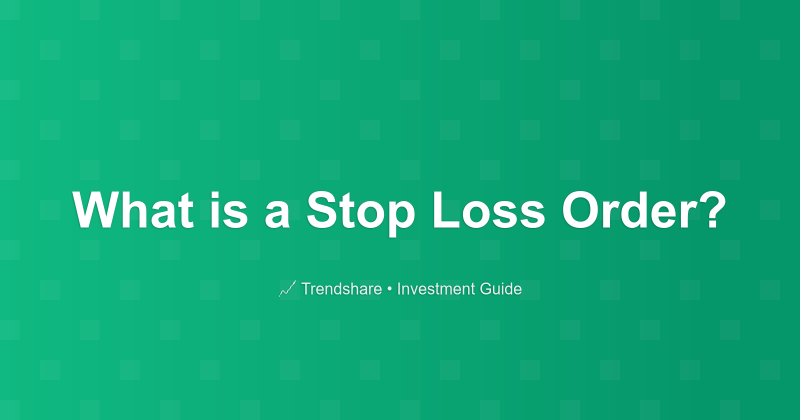
What is a Stop Loss Order?
By Ethan Mercer
Financial Technology Analyst • 10+ years in fintech and payments
A stop-loss order can help you lose money if your stock price goes down. It can also cost you money.
Value investors look at the long term. Buying a stock that's on sale and waiting for the market to catch up to its fair price takes a log time. It may, in fact, never happen—or it may take longer to happen than you can wait.
Patience is a virtue, but if the market occasionally misprices things, you have to accept that the market can be irrational for a long time. Sometimes that great opportunity that's gone on sale will keep going on sale, dropping its price further and further.
Cut Your Losses
It hurts to sell a stock at a loss, but there are good reasons to do it:
- You've revised your story for the stock, and the opportunity just isn't there.
- You have a better opportunity for the money you can reclaim.
- You're going to lose more money if you wait.
- The loss will help your taxes.
Okay, the latter is a little tongue in cheek, but it's not wrong. The third is the most important. This is the reason a stop-loss order exists.
A stop-loss order is a standing order to your broker to sell a stock when its price reaches a certain threshold. For example, you could decide that Alcoa is worth at least $30 a share, and you're going to get out of it if the price dips below that.
Why Use a Stop-Loss Order?
If you have a day job or a bunch of stocks or anything to do during the day besides monitor the price swings of everything you own, you can't always be available to sell at a moment's notice. Nor should you want to; the whole point of value investing is to take the buy-and-sell-immediately drama out of holding your portfolio!
If, instead, you set up a stop-loss order with your broker, you could have them trade on your behalf when Alcoa's price hit your pre-determined limit. Even if you weren't watching its price slip, your sell would execute and you'd have your money in your account.
Why not Use a Stop-Loss Order?
Of course, that's not always what you really want. You're relying on a computer to take a triggered action without knowing the context of why that event was triggered!
For example:
- Did the market as a whole go down today? Maybe some awful international crisis struck, and the entire market is off a few percentage points. That happens.
- Did an analyst give the stock a bad rating? That happens. That may cause you to change your own story, but it may not.
- Is this a temporary blip marked by extra high or extra low trading volume? Especially for stocks of low liquidity, prices can fluctuate dramatically without reflecting too much on the underlying strength or weakness of a business.
Furthermore, there's one huge flaw in the implementation of stop-loss orders. Even though you may have set a $30 price on Alcoa, you're not guaranteed to sell for $30. You'll sell at whatever market price you can get after it's crossed that $30 threshold on the way down. That could be $30 or $29.95... or $25 or even $20. (This is technically called a Stop Loss Market Order. It's the most common type of stop loss order.)
This is the argument against using a stop-loss order: you need to evaluate the context of the price drop in totality and you need the flexibility to set the new price you're willing to accept.
Fortunately, alternatives exist.
Alternatives to Stop-Loss Orders
Instead of using a stop-loss order, you can often set up a trigger notification with your broker to notify when your stock has reached a trigger price. You'll have to make a decision on your own what to do at that point, but you have the ability to make that decision on your own.
Perhaps you'll wait for the price to rebound or set up your own sale price regardless of current market price.
Another option is a stop-limit order to sell the stock at a predetermined price when the price trigger has executed. Unlike a stop-loss order which will sell Alcoa for whatever it can get below $30 when it dips below $30, a stop-limit order could immediately offer to sell for $29.95 so as to lose as little money as possible. There's no guarantee anyone will buy at that price, but it'll protect more capital than if the price went down to $20.
In the end, the approach comes down to what you can afford to risk. The best strategy is always good research and patience, but savvy investors can use tools to protect themselves against unforeseen risk. Even so, keep in mind that the market can move quickly in irrational ways, so understand the risk you can tolerate and make wise investments based on that, rather than any tool which introduces complexity and uncertainty to your portfolio.
Investment Disclaimer
This article is for educational purposes only and does not constitute investment advice. Stock prices, financial metrics, and market conditions change constantly. Company examples are provided for illustration and should not be considered recommendations. Always verify current data from official sources such as company investor relations pages or SEC filings, assess your own risk tolerance and investment objectives, and consult a qualified financial advisor before making investment decisions. Past performance does not guarantee future results.